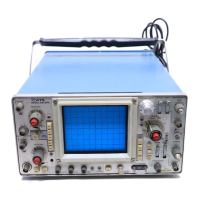TM 11-6625-2735-14-1
The A and B Trigger Generator circuits produce an
output pulse that initiates generation of the sawtooth
sweep signals produced by the A or B Sweep Generator
circuits. The input signal to the Trigger Generator circuits
can be individually selected from the Channel 1 signal,
Channel 2 signal, the signal(s) displayed on the CRT
(NORM), a signal connected to the external trigger input
connectors, or a sample of the line voltage applied to the
instrument. Each trigger circuit contains separate level,
slope, coupling, and source controls.
There are three sweep generator circuits in the 475. For
purposes of explanation, they are called Delaying, Slow
Non-Delaying, and Fast Non-Delaying. The Delaying
Sweep generates a range of sweep rates from 0.5 second
to 0.05 microsecond/division. The Slow Non-Delaying
Sweep generator provides the 0.5 second through 1
microsecond/division sweep rates and the Fast Non-
Delaying Sweep Generator provides the sweep rates of 0.5
through 0.01 microsecond/division.
The Delaying Sweep runs when the instrument is
operated in a delayed-sweep mode (MIX, A INTEN or B
DLY’D) and is displayed as the A portion of a MIX or A
INTEN display. In B DLY’D mode the Delaying Sweep is
used to delay the Non-Delaying Sweep, which is displayed
on the CRT. The sweep rate for the Delaying-Sweep
Generator is selected by the A TIME/DIV switch (skirt
knob). One of the Non-Delaying Sweeps (depending on
the sweep rate selected) will run and may be displayed in
all modes of the HORIZ DISPLAY switch. In the A mode
(knobs locked) the Non-Delaying Sweep is displayed as
the A Sweep and in the MIX mode, displayed as the B
DLY’D Sweep. In the A INTEN mode, the Non-Delaying
Sweep is displayed as the intensified portion and in the B
DLY’D mode is displayed as the B DLY’D Sweep. The
sweep rate for the Non-Delaying Sweep Generator is
selected by the B TIME/DIV switch (DLY’D SWEEP knob).
It may be helpful to see Table 3-2, found later in this
section.
The TRIG MODE switch controls the mode of operation
of the sweep generator deriving the A portion of a display.
In the AUTO position, the absence of an adequate trigger
signal causes the sweep to free run. In the NORM position,
a horizontal sweep is presented only when correctly
triggered by an adequate trigger signal. Pushing the
SINGL SWP pushbutton allows one (and only one) sweep
to be presented. The Z Axis Logic circuit produces an
unblinking gate signal to unblank the CRT so that the
display can be presented. This gate signal is coincident
with the sawtooth produced by the sweep generator. The
Z Axis Logic Circuit also produces, at the end of each
sweep, a gate signal that is supplied to the Vertical
Channel Switching circuit. This pulse switches the display
between channels at the end of each sweep when the
Vertical Deflection System is operating in the ALT mode.
The outputs of the sweep generators are amplified by
the Horizontal Amplifier to produce horizontal deflection
for the CRT except in the fully counterclockwise (X-Y)
position of the TIME/DIV switch. The Horizontal Amplifier
contains a 10X magnifier to increase the sweep rate by a
factor of 10 in any A or B TIME/DIV switch position. Other
horizontal deflection signals can be connected to the
Horizontal Amplifier by using the X-Y mode of operation.
When the TIME/DIV switch is set to X-Y, the X-axis signal
is connected to the Horizontal Amplifier circuit through
the Channel 1 Vertical Preamplifier circuit.
The Z Axis Amplifier circuit determines the CRT
intensity and blanking. The Z Axis Amplifier circuit sums
the current inputs from the INTENSITY control, the
Vertical Channel Switching circuit (chopped blanking),
the Z Axis Logic circuit (unblinking), and the external Z
AXIS INPUT connector. The output level of the Z Axis
Amplifier circuit controls the trace intensity through the
CRT circuit. The CRT circuit provides the voltages and
contains the controls necessary for operation of the
cathode-ray tube.
The Power Supply circuit provides the low voltage
power necessary for operation of this instrument. This
voltage is distributed to all of the circuits in the instrument.
The Calibrator circuit provides a square-wave output
with accurate voltage and current amplitudes, which can
be used to check the calibration of the instrument and the
compensation of probes. The CALIBRATOR current loop
provides an accurate current source for calibration of
current measuring probe systems.
CHANNEL 1 PREAMP
General
Input signals for vertical deflection on the CRT can be
connected to the CH 1 OR X input connector. In the X-Y
mode of operation, the input signal connected to the CH 1
OR X connector provides the horizontal (X-axis) deflec-
tion (TIME/DIV switch set to X-Y, VERT MODE switch set
to CH 2 OR X-Y). The Channel 1 Preamp circuit provides
control of input coupling, vertical deflection factor, gain,
and DC balance. Fig. 3-2 shows a detailed block diagram
of the Channel 1 Preamp circuit. A schematic of this circuit
is shown on Diagram 1 at the rear of this manual.
3-4

